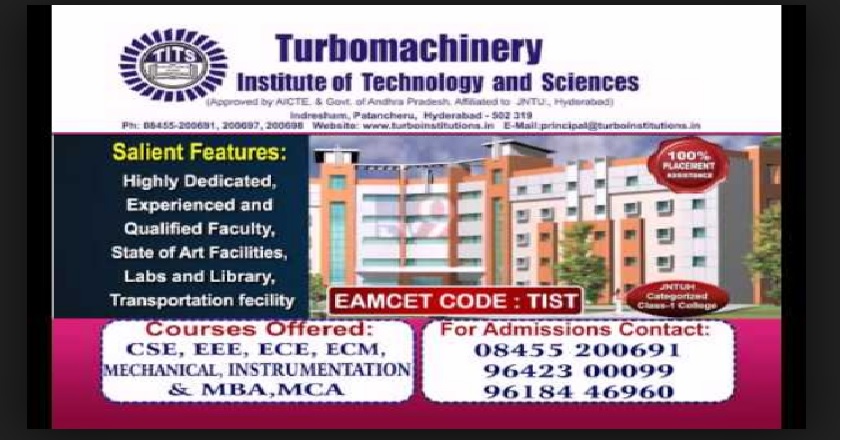Computer Organization B.Tech Question Bank : tits.ac.in
Name of the College : Turbomachinery Institute of Technology &Sciences (TITS)
University : JNTU Hyderabad
Department : Computer Science Engineering
Subject Name : Computer Organization
Degree : B.Tech
Year/Sem : III/II
Website : tits.ac.in
Document Type : Question Bank
Download Model Question Paper : https://www.pdfquestion.in/uploads/tits.ac.in/3049-coqb.pdf
Computer Organization Question Paper
Unit-1
1. Explain about sign magnitude and 2’s complement approaches for representing the fixed point numbers. Why 2’s complement is preferable.
2. Give means to identify whether or not an overflow has occurred in 2s complement addition or subtraction operations. Take one example for each possible situation and explain. Assume 4 bit registers. (Feb 2008 set 1)
Related : Turbomachinery Institute of Technology & Sciences Software Engineering B.Tech Question Bank : www.pdfquestion.in/3064.html
3. Explain about various buses such as internal, external, backplane, I/O, system, address, data, synchronous and asynchronous.
4. Distinguish between error detection and correction codes. What do you understand by odd parity and even parity? What is odd function and even function?. To calculate odd and even parity values which functions can be used? Calculate Odd and even parity values for all hexadecimal digits 0-9 and A-F. (Nov 2007 set 3)

5. Explain about daisy chain based bus arbitration.(Nov 2007 set 4)
6. Convert the following decimal numbers to the bases indicated.
i. 7562 to octal
ii. 175 to binary
iii. 1938 to hexadecimal.(Dec 2009 set 1)
7. Explain types of computers and their areas of applications.
8. Explain the functional unit of a computer system. (Dec 2009 set 2)
9. Make out differences between Multiprocessors and Multi computers.(Dec 2009 set 3)
10. Explain the Bus structure of a computer system with neat bus interconnection scheme diagram. (Dec 2009 set 4)
Unit-2
1. What is the use of buffers. Explain about tri-state buffers. Explain about high impedance state.
2. Explain commonly employed bit shift operators such as shift left, right, circular shift left/right and arithmetic shift left/right. Assume an 8-bit register, give an example for each? (Feb 2008 set 2)
3. Design a circuit to increment, decrement, complement and clear a 4 bit register using RS flip-flops. Explain the control logic.(Feb 2008 set 3)
4. Design registers selection circuit to select one of the four 4-bit registers content on to bus. Give fuller explanation.(Nov 2007 set 2)
5.What are register transfer logic languages? Explain few RTL statements for branching with their actual functioning. (Nov 2007 set 4)
6. Explain about instruction, fetch, and decode cycles for a memory reference instruction. Draw a flow chart also to explain the same. Indicate clearly where and which processor registers comes into picture. Now let us assume while a instruction is in the middle of its decode cycle a interrupt is arrived. What is going to happen? Is the instruction is completed or not. If we want to stop there itself and handle the interrupt what are the difficulties?(May 2009 set 3)
7. What is the difference between a direct and an indirect address instruction? How many references to memory are needed for each type of instruction to bring an operand into a processor register?
8. Give the 3 instruction code formats of a basic computer.(Dec 2009 set 1)
9. Describe the instruction cycle with the help of a neat diagram. Also draw the flow chart for the same. (Dec 2009 set 2)
10. List the various registers of a computer system. Explain the function of each register.
11. Briefly explain about shift micro operations of computer system.(Dec 2009 set 3)
12. Draw a Bus system for four registers using Multiplexers. Explain it in detail.
13. Explain 4-bit Address Subtracted using a neat diagram.(Dec 2009 set 4)
Unit-3
Micro Programmed Control : Control memory, Address sequencing, microprogram example, design of control unit Hard wired control. Microprogrammed control
1. Explain about stack organization used in processors. What do you understand by register stack and memory stack?
2. Explain how X= (A+B)/(A-B) is evaluated in a stack based computer.(Feb 2008 set 1) (Nov 2007 set 3)
3. Write about direct, indirect, register direct, register indirect, immediate, implicit, relative, index, and base address mode of addressing. Why do we need so many addressing modes? Is the instruction size influenced by the number of addressing modes which a processor supports? State whether the number of addressing modes will be more in RISC or CISC? (Nov 2007 set 1)
4. Support the statement Instruction Set Architecture has impact on the processors micro architecture. (Feb 2008 set 4) (Nov 2007 set 4)
5. Why do we need subroutine register in a control unit? Explain. (Nov 2007 set 1)(May 2009 set 4)
6. Why do we need some bits of current microinstruction to generate address of the next microinstruction? Support with a live example. (May 2009 set 3)
7. How do you map micro-operation to a micro instruction address. (Nov 2007 set 3)
8. Describe how microinstructions are arranged in control memory and how they are interpreted.
9.Explain any eight addressing modes in detail.(Dec 2009 set 1) (Dec 2009 set 3)
10.Explain the characteristics of RISC. (Dec 2009 set 3)
11. Convert the expression A + B * C + (D + E) * F into reverse polish notation.
12. Write a program to evaluate the arithmetic statement X = (A + B) * (C + D).
i. Using a general register computer with two address instructions.
ii. Using stack organized computer with zero address operation instruction. (Dec 2009 set 2)
13. Explain the two ways of organizing a stack in computer system.
14. Write a brief note on sub routine call and return. (Dec 2009 set 4)